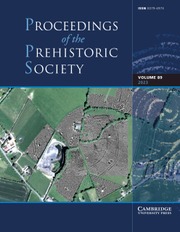Article contents
The production of specialised flintwork in the later Neolithic: a case study from the Yorkshire Wolds
Published online by Cambridge University Press: 18 February 2014
Abstract
This paper examines the evidence for specialist artefact production during the later Neolithic on the Yorkshire Wolds. It is proposed that such an industry was responsible for the production of some of the highly distinctive lithic artefacts present in that period, such as polished discoidal knives, ripple-flaked and polished oblique arrowheads, and polished flint axes. It is suggested that much of the value attached to these items derived from the highly organised but restricted nature of their production. Two sites on the Wolds were fieldwalked and the finds subjected to both technological and spatial analysis. Results indicate that an industry exercising a higher level of skill existed alongside more everyday knapping activities. This industry was divided into two phases, consisting of the roughing out of flint nodules at the stone source and the completion of the specialised artefacts in spatially restricted workshops within settlements.
- Type
- Research Article
- Information
- Copyright
- Copyright © The Prehistoric Society 1995
References
BIBLIOGRAPHY
- 4
- Cited by


